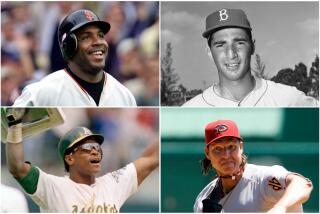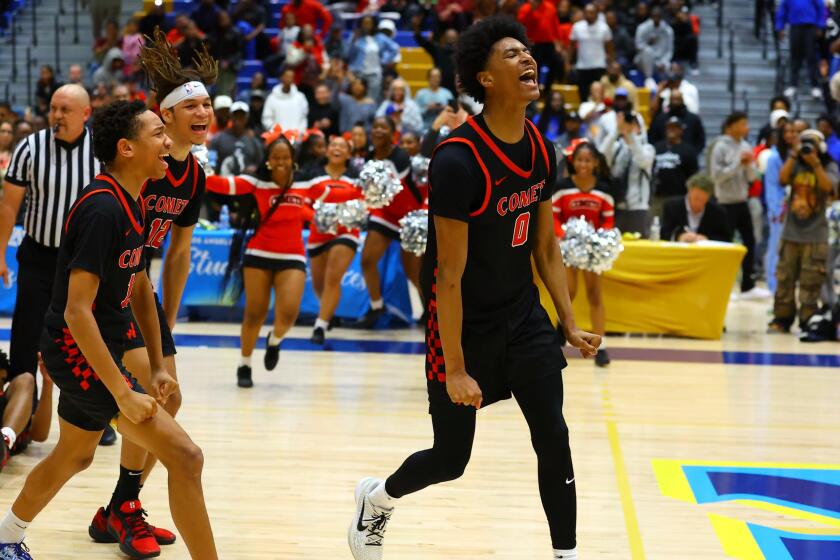Sir Donald Bradman; Cricket’s Greatest Player
- Share via
BRISBANE, Australia — Sir Donald Bradman, the Australian cricket star rated the greatest player in the history of the sport, has died.
Bradman died Sunday of pneumonia in Adelaide, South Australia. He was 92.
Bradman’s astounding test scoring average of 99.94 was 40 to 50 runs higher than that of other outstanding cricket players. South African Graeme Pollock came closest, with an average of 60.97; West Indian Sir Garfield Sobers averaged 57.78, and Englishman Sir Leonard Hutton 56.67.
His impact on the Australian sporting psyche endured more than five decades after his retirement. At 91, he was named the Australian sportsman of the century at a ceremony in 1999.
“He was a beacon of hope for a generation; he gave Australians something very tangible and something enjoyable to believe in,” Australian Prime Minister John Howard said on Bradman’s 90th birthday.
The late English player Denis Compton once described Bradman as “a batsman appearing not just once in a lifetime, but once in the life of a game.”
Bradman was born in Cootamundra in rural New South Wales on Aug. 27, 1908, and moved to Bowral, two hours south of Sydney, as a child. He honed his cricket skills behind the family house where, legend has it, he refined his technique by hitting a golf ball against a corrugated-iron water tank using a cricket stump as a bat.
In January 1930, Bradman took less than seven hours to score a world record 452 runs in a match against Queensland at the Sydney Cricket Ground, eclipsing Bill Ponsford’s mark of of 437. (In cricket, there are 10 outs to an innings and a batsman can remain on the field until the final out is recorded.)
Of the 11 test series he played, in a career interrupted by World War II, eight were against England, the remainder against South Africa, West Indies and India.
He made his first tour of England in 1930 and it elevated him to superstar status, as he scored 974 runs in seven innings, including two double centuries and a triple century.
Bradman rated his 254 runs in the second test at Lord’s as his finest moment because “practically without exception, every ball went where it was intended to go,” and it made him the youngest player to score a test double hundred.
He scaled greater heights in the next match, becoming the first player to score a triple century in a test, with 334 runs in 378 minutes at Headingley.
Bradman’s dominance in 1930 forced England to devise the so-called bodyline tactics to counter him in the 1932-33 series. England captain Douglas Jardine grouped fielders close to the Australian batsmen and then ordered his bowlers--the cricketing equivalent of pitchers--to aim short-pitched balls that bounced off the turf at the batsman’s body.
Jardine became public enemy No. 1 in Australia, but he restricted Bradman to a series average of 56.57, the worst of his career, before bodyline was banned.
Bradman was Australian captain from 1936 until he retired after the England tour in 1948. As skipper, he had 15 wins, 6 draws and 3 losses, including two defeats in his first two tests at the helm in a home series against England. But he turned the series with a 270 in the third test that set his team toward a 3-2 series triumph.
Bradman suffered ill health through the war years but returned as captain in 1946, at age 38.
Bradman finished his career after 234 first-class matches, batting 338 times for 28,067 runs at an average of 95.14, including 117 centuries. These did not include test matches, which are games played between international opponents.
After his retirement Bradman seldom ventured out for public engagements. He worked as a stockbroker and rejected all public endorsements.
“I hate fame,” Bradman said. “I’m just an ordinary human being. I don’t like publicity of any kind.”
He suffered a mild stroke in 1996 and lost his childhood sweetheart, Jessie, to cancer in September 1997 after 65 years of marriage. The couple had two children, John and Shirley.
More to Read
Go beyond the scoreboard
Get the latest on L.A.'s teams in the daily Sports Report newsletter.
You may occasionally receive promotional content from the Los Angeles Times.








